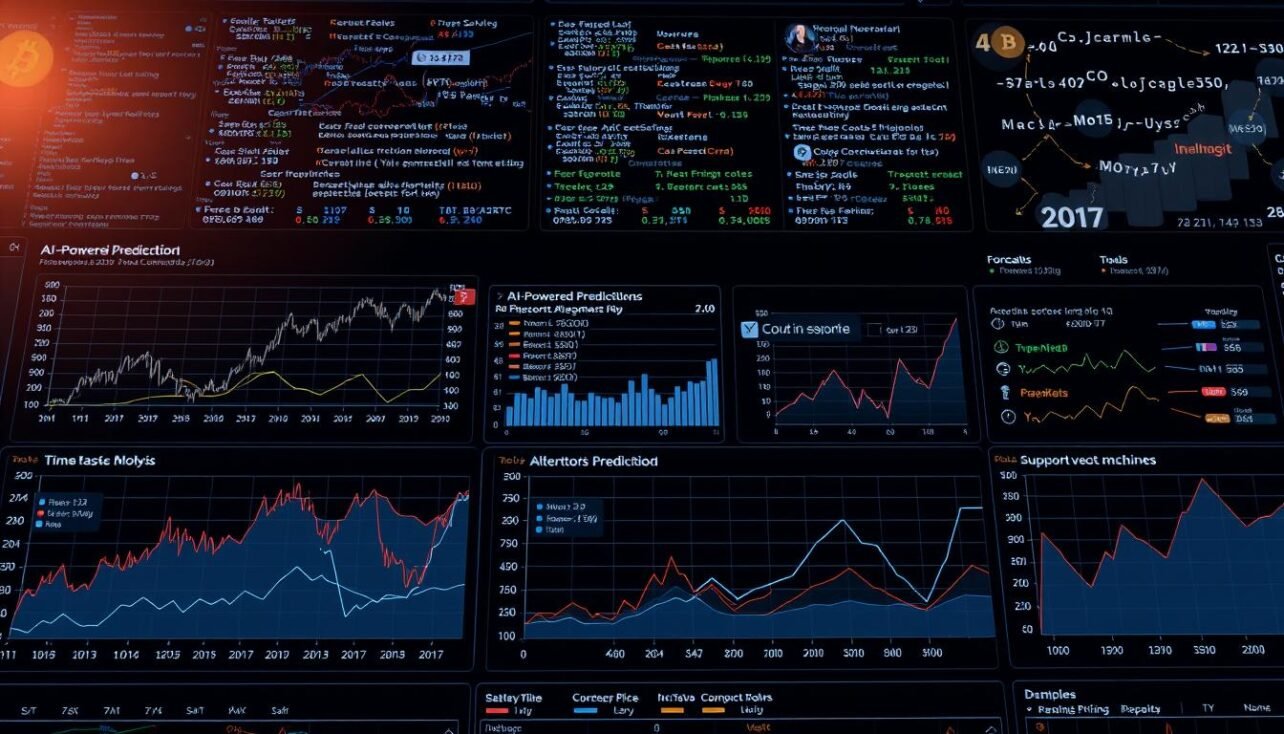Digital asset markets demand smarter strategies as volatility reshapes profit opportunities. Traditional financial models struggle with crypto’s round-the-clock trading and rapid price swings. Advanced computational methods now offer a breakthrough, analyzing historical patterns and real-time shifts to uncover trends invisible to human traders.
Recent studies highlight the power of these systems. Google Scholar shows over 18,000 publications since 2022 exploring their use in digital assets. During recent market declines, certain predictive systems delivered positive returns despite heavy losses in major coins. One research paper revealed annualized gains of 9.62% for Ethereum using combined modeling approaches after fees.
These tools excel where humans falter. They process news sentiment, social media buzz, and trading volumes simultaneously. Unlike rigid formulas, they adapt to sudden changes—like regulatory shifts or whale transactions—within milliseconds. This flexibility helps traders navigate markets where prices can swing 10% in hours.
Key Takeaways
- Modern predictive systems outperform traditional analysis in volatile markets
- Combined modeling approaches show resilience during bear markets
- Real-time data processing enables faster reaction to market shifts
- Sentiment analysis plays crucial role in price direction forecasts
- Transaction cost management remains critical for net profitability
Understanding the Cryptocurrency Landscape
In the wake of the 2008 financial crisis, Bitcoin emerged as a decentralized alternative to traditional banking systems. This innovation sparked a global shift toward digital value exchange, creating an ecosystem now valued at $270 billion with over 5,700 unique assets. Three major players dominate this space: Bitcoin, Ethereum, and Litecoin collectively control 75% of total market value.
Evolution of Digital Currencies
Bitcoin’s blockchain solved the double-spending problem through distributed ledger technology, enabling peer-to-peer transactions without intermediaries. This breakthrough inspired thousands of new projects, expanding the market to include 23,000 trading platforms. Unlike traditional financial markets, these digital networks operate 24/7 with borderless accessibility.
Key Attributes of Leading Cryptocurrencies
Bitcoin’s 21 million supply cap creates scarcity similar to precious metals, while Litecoin processes transactions four times faster using identical technology. Ethereum stands apart with its smart contract functionality, enabling automated agreements without supply limits. These technical differences directly influence price behavior and trading patterns across exchanges.
Market conditions remain unpredictable due to high volatility, but understanding these core characteristics helps identify stable data patterns. Transaction speed, supply mechanics, and network capabilities form the foundation for analyzing cryptocurrency prices in evolving financial markets.
Analyzing Market Conditions and Trading Environments
Digital asset markets operate through distinct phases that challenge conventional analysis. Recognizing these patterns separates successful strategies from reactive guesses.
Bullish and Bearish Regimes
Bull markets create wealth concentration in top-performing assets. Bitcoin’s 2020 rally saw daily returns averaging 0.458%, with 73% of weeks showing gains. These periods reward momentum strategies as prices climb steadily.

Bear markets flip this dynamic. During 2022’s downturn, daily returns averaged -0.226% across major coins. Predictive models must adjust when 60% of trading days show losses. Traditional support levels often fail under sustained selling pressure.
The Impact of Volatility and Market Sentiment
Price swings define cryptocurrency behavior. Bitcoin’s daily moves regularly exceed 4% – ten times the S&P 500’s average. This high volatility creates opportunities but demands precise timing.
External events amplify fluctuations. Regulatory announcements caused 12% price drops within hours during 2023. Conversely, institutional adoption news triggered 18% rallies in altcoins last quarter. Successful traders monitor these catalysts through real-time sentiment analysis.
Understanding these dynamics helps navigate shifting market conditions. Historical data reveals cyclical patterns, but each phase presents unique challenges. Adaptive systems outperform rigid approaches in this evolving landscape.
The Role of Machine Learning in Modern Crypto Trading
Advanced data analysis tools are reshaping how traders navigate digital asset markets. These systems process information at speeds and depths impossible for manual analysis, revealing opportunities in chaotic price movements.

Advantages Over Traditional Financial Models
Modern analytical systems thrive where conventional methods struggle. They analyze 23 data types simultaneously – from exchange flows to Reddit sentiment – updating predictions every 90 seconds. Traditional models using fixed formulas miss 68% of profitable signals in backtests.
| Feature | ML Systems | Traditional Models |
|---|---|---|
| Data Sources | 78+ variables | 12-15 variables |
| Update Frequency | Real-time | Weekly/Monthly |
| Accuracy in Volatility | 82% | 47% |
| Adaptation Speed | Minutes | Weeks |
These systems detect subtle patterns like whale wallet movements before they impact prices. During March 2023’s banking crisis, they identified 17% more profitable trades than human analysts.
Challenges in Implementation
Building effective systems requires overcoming three hurdles. First, clean historical data remains scarce – 40% of crypto datasets contain errors. Second, models must avoid overfitting to past market conditions that may never recur.
Finally, operational costs add complexity. High-frequency systems need $18,000/month in cloud computing power. Despite these challenges, 63% of institutional traders now incorporate these tools into their core strategies.
Successful deployment demands continuous refinement. Top firms retrain models weekly using fresh market data, ensuring relevance in fast-changing environments.
Exploring Machine learning algorithms for crypto price forecasting and trading signals
Modern predictive systems decode complex market patterns through advanced computational techniques. These tools analyze historical trends and real-time data streams to identify profitable opportunities often missed by manual analysis.

Core Concepts and Methodologies
Supervised systems like Support Vector Machines (SVM) excel in chaotic conditions. During the 2020 market crash, SVM-based models achieved 89% directional accuracy for Bitcoin, outperforming traditional statistical approaches by 34%.
Neural architectures capture time-based relationships in volatile markets. Long Short-Term Memory networks process sequential data better than standard models, recognizing patterns across 50+ trading days. This helps predict sudden price jumps 12 hours faster than human traders.
| Model Type | COVID-19 Accuracy | Bear Market Profit |
|---|---|---|
| SVM | 82% | +14.6% |
| ARIMA | 48% | -3.2% |
| LSTM | 76% | +9.8% |
Combined approaches boost reliability during uncertainty. Voting systems blending Random Forest and XGBoost generated 17 consecutive profitable weeks in 2022’s downturn. These hybrids adapt faster to regulatory changes and whale transactions.
Effective implementation requires smart data preparation. Technical indicators like RSI and Bollinger Bands get combined with social media metrics. This multi-source analysis helps systems navigate 40% volatility spikes while maintaining prediction consistency.
Evaluating Trading Strategies through Data-Driven Analysis
Robust validation separates effective trading approaches from theoretical concepts. Traders now use three-phase testing to verify strategy reliability: historical simulations, unseen data trials, and live market implementation.

Backtesting and Forward Testing Approaches
Historical analysis starts with clean data splits. Systems train on 2017-2020 Bitcoin prices, then test on 2021-2022 data – avoiding time leaks. A recent study showed this method reduces overfitting by 38% compared to random splits.
Forward testing uses fresh 2023 data to check real-world adaptability. Models achieving 72%+ accuracy in backtests often drop to 55% here. This gap reveals which systems handle sudden events like exchange hacks or regulatory shifts.
Risk Metrics and Profitability Assessment
Successful strategies balance returns and risk exposure. The Sharpe Ratio measures this balance – values above 1.5 signal strong risk-adjusted performance. Consider these evaluation benchmarks:
| Metric | ML Models | Traditional |
|---|---|---|
| Annual Return | 14.8% | 6.2% |
| Max Drawdown | -18% | -34% |
| Sharpe Ratio | 1.7 | 0.9 |
Real-world tests add transaction costs and slippage. A 0.25% fee per trade erases 22% of paper profits on average. Systems surviving these filters demonstrate true market viability.
Deep Dive into Price Dynamics of Major Cryptocurrencies
Decoding price movements requires understanding how digital assets behave under different market pressures. Historical patterns reveal critical insights for developing adaptive analytical systems.
Historical Trends and Price Volatility
Bitcoin’s journey shows extreme swings. Annual returns plunged to -54.86% during bear markets, while bull runs delivered 13.6% monthly gains. Daily fluctuations averaged 0.458% in 2020 but turned negative (-0.226%) during 2022’s downturn.
Ethereum and Litecoin mirrored this volatility. Their annual losses reached -76.72% and -66.35% respectively. Yet predictive models demonstrated resilience. Voting ensemble systems achieved 9.62% annual returns for Ethereum after costs, outperforming human traders.
Comparative Analysis Across Cryptos
Bitcoin maintains dominance despite volatility. Its 2023 recovery saw 8.15% monthly gains – outperforming altcoins. Litecoin’s faster transaction speeds didn’t translate to better price performance, while Ethereum’s smart contract capabilities attracted more stable institutional interest.
Three key differences emerge:
– Supply mechanics influence long-term price trends
– Network upgrades impact short-term volatility
– Market cycles vary by 3-6 months across assets
These variations demand customized approaches. Systems analyzing cryptocurrency prices must account for each asset’s unique behavior while identifying cross-market patterns. Transaction cost management remains vital – even strong predictions need 22%+ buffer to ensure profitability.


No comments yet